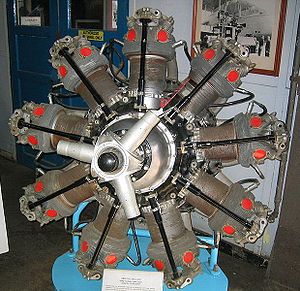Bristol Pegasus
| Pegasus | |
|---|---|
 |
|
| Preserved Bristol Pegasus on display at the Brooklands Museum. The red circles are temporary blanking plates removed when the exhaust manifold is fitted | |
| Type | Piston aero engine |
| Manufacturer | Bristol Aeroplane Company |
| First run | c.1932 |
| Major applications |
Fairey Swordfish Short Sunderland Vickers Wellington |
| Number built | c.32,000 |
| Developed from | Bristol Jupiter |
| Developed into |
Bristol Draco Bristol Phoenix |
The Bristol Pegasus is a British nine-cylinder, single-row, air-cooled radial aero engine. Designed by Roy Fedden of the Bristol Aeroplane Company it was used to power both civil and military aircraft of the 1930s and 1940s. Developed from the earlier Mercury and Jupiter engines, later variants could produce 1,000 horsepower (750 kW) from its capacity of 1,750 cubic inches (28 L) by use of a geared supercharger.
Further developments of the Pegasus created the fuel-injected Bristol Draco and the diesel cycle Bristol Phoenix, both types being produced in limited numbers. In contrast, by the end of production over 30,000 Pegasus engines had been built. Aircraft applications ranged from single-engine biplanes to the four-engined Short Sandringham and Sunderland flying boats. Several altitude and distance records were set by aircraft using the Pegasus.
The Bristol Siddeley company reused the name many years later for the turbofan engine used in the Hawker Siddeley Harrier and which became known as the Rolls-Royce Pegasus when Rolls-Royce took over that company. Two Bristol Pegasus engines remain airworthy in 2010, powering Fairey Swordfish aircraft operated by the Royal Navy Historic Flight, other examples are preserved and on public display in aviation museums.
...
Wikipedia
